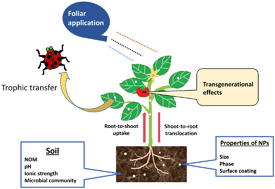当前位置:
X-MOL 学术
›
Environ. Sci.: Nano
›
论文详情
Our official English website, www.x-mol.net, welcomes your
feedback! (Note: you will need to create a separate account there.)
Interaction of titanium dioxide nanoparticles with soil components and plants: current knowledge and future research needs – a critical review
Environmental Science: Nano ( IF 5.8 ) Pub Date : 2017-12-18 00:00:00 , DOI: 10.1039/c7en00985b Wenjuan Tan 1, 2, 2, 3, 4 , Jose R. Peralta-Videa 1, 2, 2, 3, 4 , Jorge L. Gardea-Torresdey 1, 2, 2, 3, 4
Environmental Science: Nano ( IF 5.8 ) Pub Date : 2017-12-18 00:00:00 , DOI: 10.1039/c7en00985b Wenjuan Tan 1, 2, 2, 3, 4 , Jose R. Peralta-Videa 1, 2, 2, 3, 4 , Jorge L. Gardea-Torresdey 1, 2, 2, 3, 4
Affiliation

|
Titanium dioxide nanoparticles (nano-TiO2), one of the most produced engineered nanoparticles (ENPs), are used in pigments, photocatalysis, food additives, and personal care products. This broad variety of applications has led to the unusual and widespread distribution of nano-TiO2 in several environmental sectors, with different effects on living organisms. In the last decade, several publications have shown fragments of information about the interaction, detection, uptake, and translocation of nano-TiO2 in plants. This review includes a discussion of the current knowledge about factors affecting the interaction of nano-TiO2 with soil and plants. We also discuss the role of particle size, crystal phase, surface coating, and techniques employed to study the interaction of these nanoparticles with plants. Concluding results from synchrotron based, microscopic, physiological, and biochemical analyses of plants exposed to nano-TiO2 are presented. However, the current information leaves no doubt that there are still many aspects in need of additional investigations to fully understand the effects of nano-TiO2 in plants. For instance, little is known about the transgenerational effects of nano-TiO2 exposure and the changes at agronomical and physiological levels. The effects of such ENPs in proteins and other metabolites are also not well understood. In addition, more information is needed about the interaction of nano-TiO2 with other ENPs-and-organic co-contaminates and the effects of plants. Since nano-TiO2 have been found in edible tissues, it is expected that they will be in the food chain; thus, studies on their trophic transfer are required. The authors hope that, besides contributing to a better understanding of current data about the effects of nano-TiO2 in soil and plants, this review will help to drive future investigations and will contribute to the general knowledge on the environmental interactions of engineered nanomaterials.
中文翻译:

二氧化钛纳米粒子与土壤成分和植物的相互作用:当前的知识和未来的研究需求–严格审查
二氧化钛纳米颗粒(nano-TiO 2)是生产量最大的工程化纳米颗粒(ENP)之一,用于颜料,光催化,食品添加剂和个人护理产品中。广泛的应用导致纳米TiO 2在几个环境领域的异常广泛分布,对生物体产生不同的影响。在过去的十年中,一些出版物显示了有关植物中纳米TiO 2的相互作用,检测,吸收和转运的信息的片段。这篇综述包括对有关影响纳米TiO 2相互作用的因素的当前知识的讨论。与土壤和植物。我们还讨论了粒径,晶相,表面涂层以及用于研究这些纳米粒子与植物相互作用的技术的作用。得出了基于同步加速器的,暴露于纳米TiO 2的植物的微观,生理和生化分析的结论性结果。但是,目前的信息无疑表明,仍有许多方面需要进一步研究以充分了解纳米TiO 2在植物中的作用。例如,对纳米TiO 2的转世效应知之甚少暴露以及农艺和生理水平的变化。此类ENP在蛋白质和其他代谢物中的作用也未得到很好的理解。此外,还需要更多有关纳米TiO 2与其他ENP和有机共污染物质的相互作用以及植物效应的信息。由于已经在可食用的组织中发现了纳米TiO 2,因此预计它们将出现在食物链中。因此,需要研究它们的营养转移。作者希望,除了有助于更好地了解有关土壤和植物中纳米TiO 2影响的当前数据外,本综述还将有助于推动未来的研究,并有助于了解工程纳米材料与环境的相互作用的常识。
更新日期:2017-12-18
中文翻译:

二氧化钛纳米粒子与土壤成分和植物的相互作用:当前的知识和未来的研究需求–严格审查
二氧化钛纳米颗粒(nano-TiO 2)是生产量最大的工程化纳米颗粒(ENP)之一,用于颜料,光催化,食品添加剂和个人护理产品中。广泛的应用导致纳米TiO 2在几个环境领域的异常广泛分布,对生物体产生不同的影响。在过去的十年中,一些出版物显示了有关植物中纳米TiO 2的相互作用,检测,吸收和转运的信息的片段。这篇综述包括对有关影响纳米TiO 2相互作用的因素的当前知识的讨论。与土壤和植物。我们还讨论了粒径,晶相,表面涂层以及用于研究这些纳米粒子与植物相互作用的技术的作用。得出了基于同步加速器的,暴露于纳米TiO 2的植物的微观,生理和生化分析的结论性结果。但是,目前的信息无疑表明,仍有许多方面需要进一步研究以充分了解纳米TiO 2在植物中的作用。例如,对纳米TiO 2的转世效应知之甚少暴露以及农艺和生理水平的变化。此类ENP在蛋白质和其他代谢物中的作用也未得到很好的理解。此外,还需要更多有关纳米TiO 2与其他ENP和有机共污染物质的相互作用以及植物效应的信息。由于已经在可食用的组织中发现了纳米TiO 2,因此预计它们将出现在食物链中。因此,需要研究它们的营养转移。作者希望,除了有助于更好地了解有关土壤和植物中纳米TiO 2影响的当前数据外,本综述还将有助于推动未来的研究,并有助于了解工程纳米材料与环境的相互作用的常识。











































 京公网安备 11010802027423号
京公网安备 11010802027423号